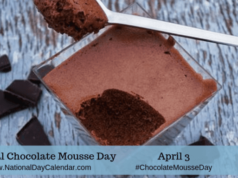
Recognized by the US National Confectioners Association, National Chocolate Mint Day is observed annually across the nation on February 19th. This holiday has been set aside for all the chocolate mint lovers to eat their favorite treats all day long.
- The Aztecs and Mayans are given much credit for their ways with chocolate, and while chocolate was brought back to Europeans, they were not fond of the dark, bitter bean, and it was used more for medicinal purposes.
- As it was mostly consumed as a hot beverage, Europeans mixed mint, cinnamon and other spices to make it more palatable. Over time, sugar was added, and the combination of chocolate and mint became fashionable.
- Fast forward to the mid-1800s when inventions and improvements in processes made it possible for confectioners to begin mass producing chocolates. Even then, small candy shops served a local public. Advertisements for mint chocolates, or chocolate mints, did not start showing up in newspapers until the turn of the century.
- The International Dairy Foods Association states that mint chocolate chip is the 10th most popular flavor of ice cream.
- One of the earliest mass-producers of chocolate mints was Huyler’s in New York, which had a chain of stores across the country.
- Girl Scout Thin Mint cookies were first sold in 1953 and are still their most popular cookie.
- Thin Mints account for over 25% of the annual Girl Scout cookie sales.
- The first known record of a Girl Scout Cookies variety of a chocolate mint cookie appeared in 1939.
- The name has changed over the years — they were first called Cooky Mints!
- They weren’t called Thin Mints until 1963.
- Mint chocolate is also the name of an herb with edible leaves that taste like chocolate and mint.
- In tea houses and dinner halls of the early 1900’s mint sprigs and dark chocolates served after desserts for patrons to ‘chew for good breath and aid digestion’.
- Andes chocolate mints, created in 1921, have little to do with the Andes mountains. They were once called “Andy’s Candies” but the owner ‘found that men did not like giving boxes of candies with another man’s name on them to their wives and girlfriends’ so he changed the name.
- Frango Mints, perhaps the first chocolate mints, were first patented in 1918. They were sold in tea houses and sold frozen to emphasize the sharp mint flavor.
- Ancient Greeks believed mint could cure hiccups.
- Peppermint is the number 1 selling flavor among non-chocolate, hard candies.
- The most common mint flavors are peppermint and spearmint, but there are more than 20 types of mints growing around the world.
- Mint’s essential oils are used in perfume, cosmetics, air fresheners, drink flavorings, candies and medications.
- The US produces 70% of the Worlds peppermint and spearmint,
- Peppermint has escaped cultivation and can be found growing wild in moist areas throughout Europe and North America.
- Peppermint has been used in Eastern and Western traditional medicine as an aromatic, antispasmodic, and antiseptic in treating indigestion, nausea, sore throat, colds, toothaches, cramps, and cancers.
Sources:












